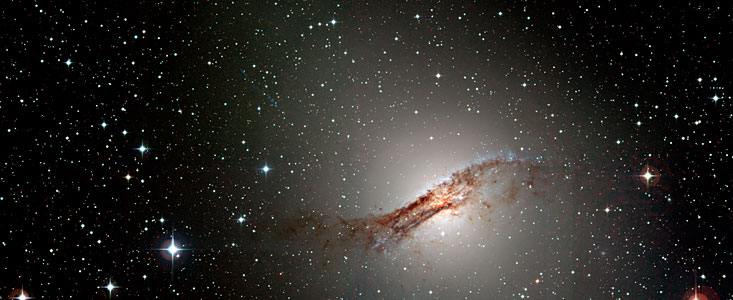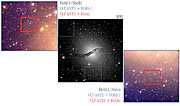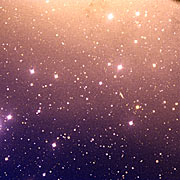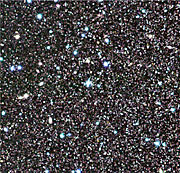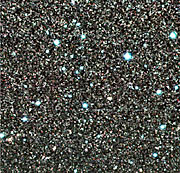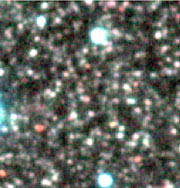Comunicato Stampa
One Thousand "Wonderful" Stars Discovered in Centaurus A
First-Ever Census of Variable Mira-Type Stars in Galaxy Outside the Local Group
10 Giugno 2003
An international team led by ESO astronomer Marina Rejkuba [1] has discovered more than 1000 luminous red variable stars in the nearby elliptical galaxy Centaurus A (NGC 5128). Brightness changes and periods of these stars were measured accurately and reveal that they are mostly cool long-period variable stars of the so-called "Mira-type." The observed variability is caused by stellar pulsation. This is the first time a detailed census of variable stars has been accomplished for a galaxy outside the Local Group of Galaxies (of which the Milky Way galaxy in which we live is a member). It also opens an entirely new window towards the detailed study of stellar content and evolution of giant elliptical galaxies . These massive objects are presumed to play a major role in the gravitational assembly of galaxy clusters in the Universe (especially during the early phases). This unprecedented research project is based on near-infrared observations obtained over more than three years with the ISAAC multi-mode instrument at the 8.2-m VLT ANTU telescope at the ESO Paranal Observatory.
Mira-type variable stars
Among the stars that are visible in the sky to the unaided eye, roughly one out of three hundred (0.3%) displays brightness variations and is referred to by astronomers as a "variable star". The percentage is much higher among large, cool stars ("red giants") - in fact, almost all luminous stars of that type are variable. Such stars are known as Mira-variables ; the name comes from the most prominent member of this class, Omicron Ceti in the constellation Cetus (The Whale), also known as "Stella Mira" (The Wonderful Star). Its brightness changes with a period of 332 days and it is about 1500 times brighter at maximum (visible magnitude 2 and one of the fifty brightest stars in the sky) than at minimum (magnitude 10 and only visible in small telescopes) [2].
Stars like Omicron Ceti are nearing the end of their life. They are very large and have sizes from a few hundred to about a thousand times that of the Sun. The brightness variation is due to pulsations during which the star's temperature and size change dramatically.
In the following evolutionary phase, Mira-variables will shed their outer layers into surrounding space and become visible as planetary nebulae with a hot and compact star (a "white dwarf") at the middle of a nebula of gas and dust.
Several thousand Mira-type stars are currently known in the Milky Way galaxy and a few hundred have been found in other nearby galaxies, including the Magellanic Clouds.
The peculiar galaxy Centaurus A
Centaurus A (NGC 5128) is the nearest giant galaxy, at a distance of about 13 million light-years. It is located outside the Local Group of Galaxies to which our own galaxy, the Milky Way, and its satellite galaxies, the Magellanic Clouds, belong.
Centaurus A is seen in the direction of the southern constellation Centaurus. It is of elliptical shape and is currently merging with a companion galaxy, making it one of the most spectacular objects in the sky, cf. ESO Press Photo eso0315 . It possesses a very heavy black hole at its centre and is a source of strong radio and X-ray emission.
During the present research programme, two regions in Centaurus A were searched for stars of variable brightness; they are located in the periphery of this peculiar galaxy, cf. eso0315b . An outer field ("Field 1") coincides with a stellar shell with many blue and luminous stars produced by the on-going galaxy merger; it lies at a distance of 57,000 light-years from the centre. The inner field ("Field 2") is more crowded and is situated at a projected distance of about 30,000 light-years from the centre..
Three years of VLT observations
Under normal circumstances, any team of professional astronomers will have access to the largest telescopes in the world for only a very limited number of consecutive nights each year. However, extensive searches for variable stars like the present require repeated observations lasting minutes-to-hours over periods of months-to-years. It is thus not feasible to perform such observations in the classical way in which the astronomers travel to the telescope each time.
Fortunately, the operational system of the VLT at the ESO Paranal Observatory (Chile) is also geared to encompass this kind of long-term programme. Between April 1999 and July 2002, the 8.2-m VLT ANTU telescope on Cerro Paranal in Chile) was operated in service mode on many occasions to obtain K-band images of the two fields in Centaurus A by means of the near-infrared ISAAC multi-mode instrument. Each field was observed over 20 times in the course of this three-year period ; some of the images were obtained during exceptional seeing conditions of 0.30 arcsec. One set of complementary optical images was obtained with the FORS1 multi-mode instrument (also on VLT ANTU) in July 1999.
Each image from the ISAAC instrument covers a sky field measuring 2.5 x 2.5 arcmin 2. The combined images, encompassing a total exposure of 20 hours are indeed the deepest infrared images ever made of the halo of any galaxy as distant as Centaurus A, about 13 million light-years.
Discovering one thousand Mira variables
Once the lengthy observations were completed, two further steps were needed to identify the variable stars in Centaurus A .
First, each ISAAC frame was individually processed to identify the thousands and thousands of faint point-like images (stars) visible in these fields. Next, all images were compared using a special software package ("DAOPHOT") to measure the brightness of all these stars in the different frames, i.e., as a function of time.
While most stars in these fields as expected were found to have constant brightness, more than 1000 stars displayed variations in brightness with time; this is by far the largest number of variable stars ever discovered in a galaxy outside the Local Group of Galaxies.
The detailed analysis of this enormous dataset took more than a year. Most of the variable stars were found to be of the Mira-type and their light curves (brightness over the pulsation period) were measured, cf. ESO Press Photo eso0315 . For each of them, values of the characterising parameters, the period (days) and brightness amplitude (magnitudes) were determined. A catalogue of the newly discovered variable stars in Centaurus A has now been made available to the astronomical community via the European research journal Astronomy & Astrophysics.
Marina Rejkuba is pleased and thankful: "We are really very fortunate to have carried out this ambitious project so successfully. It all depended critically on different factors: the repeated granting of crucial observing time by the ESO Observing Programmes Committee over different observing periods in the face of rigorous international competition, the stability and reliability of the telescope and the ISAAC instrument over a period of more than three years and, not least, the excellent quality of the service mode observations, so efficiently performed by the staff at the Paranal Observatory."
What have we learned about Centaurus A?
The present study of variable stars in this giant elliptical galaxy is the first-ever of its kind. Although the evaluation of the very large observational data material is still not finished, it has already led to a number of very useful scientific results.
Confirmation of the presence of an intermediate-age population
Based on earlier research (optical and near-IR colour-magnitude diagrams of the stars in the fields), the present team of astronomers had previously detected the presence of intermediate-age and young stellar populations in the halo of this galaxy. The youngest stars appear to be aligned with the powerful jet produced by the massive black hole at the centre.
Some of the very luminous red variable stars now discovered confirm the presence of a population of intermediate-age stars in the halo of this galaxy. It also contributes to our understanding of how giant elliptical galaxies form.
New measurement of the distance to Centaurus A
The pulsation of Mira-type variable stars obeys a period-luminosity relation. The longer its period, the more luminous is a Mira-type star.
This fact makes it possible to use Mira-type stars as "standard candles" (objects of known intrinsic luminosity) for distance determinations. They have in fact often been used in this way to measure accurate distances to more nearby objects, e.g., to individual clusters of stars and to the center in our Milky Way galaxy, and also to galaxies in the Local Group, in particular the Magellanic Clouds.
This method works particularly well with infrared measurements and the astronomers were now able to measure the distance to Centaurus A in this new way. They found 13.7 ± 1.9 million light-years, in general agreement with and thus confirming other methods.
Study of stellar population gradients in the halo of a giant elliptical galaxy
The two fields here studied contain different populations of stars. A clear dependence on the location (a "gradient") within the galaxy is observed, which can be due to differences in chemical composition or age, or to a combination of both.
Understanding the cause of this gradient will provide additional clues to how Centaurus A - and indeed all giant elliptical galaxies - was formed and has since evolved.
Comparison with other well-known nearby galaxies
Past searches have discovered Mira-type variable stars thoughout the Milky Way, our home galaxy, and in other nearby galaxies in the Local Group. However, there are no giant elliptical galaxies like Centaurus A in the Local Group and this is the first time it has been possible to identify this kind of stars in that type of galaxy.
The present investigation now opens a new window towards studies of the stellar constituents of such galaxies .
Note
[1] The team consists of Marina Rejkuba and David Silva (ESO-Garching, Germany), Tim Bedding (School of Physics and Astronomy, Sydney University, Australia) and Dante Minniti (Departamento de Astronomía and FONDAP Center for Astrophysics, Pontifica Universidad Catolica de Chile, Santiago, Chile).
[2] Mira ( Omicron Ceti ), a cool red giant star, is one of the most famous variable stars in the sky. David Fabricius (East Friesland, Germany) is recognized to have discovered it in 1596 while searching for planet Mercury. In 1638, Johann Holwarda from the same area determined its period to be 11 months and so established it as the first long-period variable discovered. In 1642, Johannes Hevelius (Danzig, now Poland) named the star Mira , "The Wonderful". It has later been found to be a binary star system. An entire class of variable stars has been named after this star. By astronomical definition, "Mira-type" stars are variables with a period of around 100 - 1000 days and with visual light variations of more than 2.5 magnitudes. .
Ulteriori Informazioni
The research described in this press release is presented in a research article, soon to appear in the European research journal Astronomy & Astrophysics ("Long Period Variables in NGC 5128: I. Catalogue" by Marina Rejkuba et al.). It is available on the web as astro-ph/0305432 .
Links
The ISAAC multi-mode instrument at the 8.2-m VLT ANTU telescope at the ESO Paranal Observatory.
Contatti
Marina Rejkuba
ESO
Garching, Germany
Tel.: +49 89 3200-6453
E-mail: mrejkuba@eso.org
Sul Comunicato Stampa
| Comunicato Stampa N": | eso0315 |
| Legacy ID: | PR 13/03 |
| Nome: | Centaurus A, NGC 5128 |
| Tipo: | Local Universe : Galaxy : Type : Elliptical Local Universe : Galaxy : Component : Central Black Hole |
| Facility: | Very Large Telescope |
| Instruments: | FORS1, ISAAC |
| Science data: | 2003A&A...406...75R |
Our use of Cookies
We use cookies that are essential for accessing our websites and using our services. We also use cookies to analyse, measure and improve our websites’ performance, to enable content sharing via social media and to display media content hosted on third-party platforms.
ESO Cookies Policy
The European Organisation for Astronomical Research in the Southern Hemisphere (ESO) is the pre-eminent intergovernmental science and technology organisation in astronomy. It carries out an ambitious programme focused on the design, construction and operation of powerful ground-based observing facilities for astronomy.
This Cookies Policy is intended to provide clarity by outlining the cookies used on the ESO public websites, their functions, the options you have for controlling them, and the ways you can contact us for additional details.
What are cookies?
Cookies are small pieces of data stored on your device by websites you visit. They serve various purposes, such as remembering login credentials and preferences and enhance your browsing experience.
Categories of cookies we use
Essential cookies (always active): These cookies are strictly necessary for the proper functioning of our website. Without these cookies, the website cannot operate correctly, and certain services, such as logging in or accessing secure areas, may not be available; because they are essential for the website’s operation, they cannot be disabled.
Functional Cookies: These cookies enhance your browsing experience by enabling additional features and personalization, such as remembering your preferences and settings. While not strictly necessary for the website to function, they improve usability and convenience; these cookies are only placed if you provide your consent.
Analytics cookies: These cookies collect information about how visitors interact with our website, such as which pages are visited most often and how users navigate the site. This data helps us improve website performance, optimize content, and enhance the user experience; these cookies are only placed if you provide your consent. We use the following analytics cookies.
Matomo Cookies:
This website uses Matomo (formerly Piwik), an open source software which enables the statistical analysis of website visits. Matomo uses cookies (text files) which are saved on your computer and which allow us to analyze how you use our website. The website user information generated by the cookies will only be saved on the servers of our IT Department. We use this information to analyze www.eso.org visits and to prepare reports on website activities. These data will not be disclosed to third parties.
On behalf of ESO, Matomo will use this information for the purpose of evaluating your use of the website, compiling reports on website activity and providing other services relating to website activity and internet usage.
Matomo cookies settings:
Additional Third-party cookies on ESO websites: some of our pages display content from external providers, e.g. YouTube.
Such third-party services are outside of ESO control and may, at any time, change their terms of service, use of cookies, etc.
YouTube: Some videos on the ESO website are embedded from ESO’s official YouTube channel. We have enabled YouTube’s privacy-enhanced mode, meaning that no cookies are set unless the user actively clicks on the video to play it. Additionally, in this mode, YouTube does not store any personally identifiable cookie data for embedded video playbacks. For more details, please refer to YouTube’s embedding videos information page.
Cookies can also be classified based on the following elements.
Regarding the domain, there are:
- First-party cookies, set by the website you are currently visiting. They are stored by the same domain that you are browsing and are used to enhance your experience on that site;
- Third-party cookies, set by a domain other than the one you are currently visiting.
As for their duration, cookies can be:
- Browser-session cookies, which are deleted when the user closes the browser;
- Stored cookies, which stay on the user's device for a predetermined period of time.
How to manage cookies
Cookie settings: You can modify your cookie choices for the ESO webpages at any time by clicking on the link Cookie settings at the bottom of any page.
In your browser: If you wish to delete cookies or instruct your browser to delete or block cookies by default, please visit the help pages of your browser:
Please be aware that if you delete or decline cookies, certain functionalities of our website may be not be available and your browsing experience may be affected.
You can set most browsers to prevent any cookies being placed on your device, but you may then have to manually adjust some preferences every time you visit a site/page. And some services and functionalities may not work properly at all (e.g. profile logging-in, shop check out).
Updates to the ESO Cookies Policy
The ESO Cookies Policy may be subject to future updates, which will be made available on this page.
Additional information
For any queries related to cookies, please contact: pdprATesoDOTorg.
As ESO public webpages are managed by our Department of Communication, your questions will be dealt with the support of the said Department.
